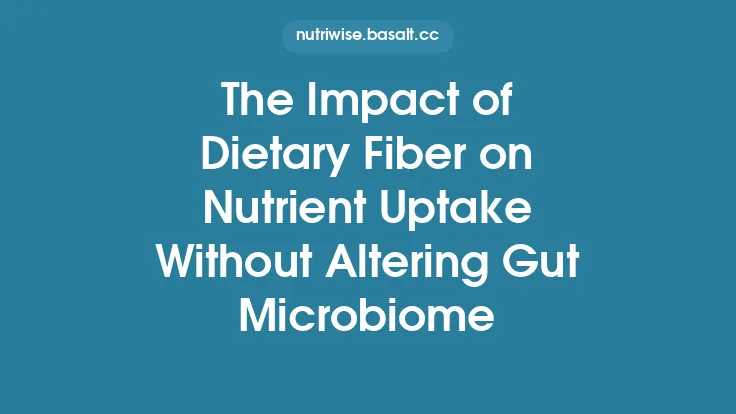Dietary fiber has long been recognized as a cornerstone of a healthy diet, yet its most profound influence unfolds within the gut ecosystem. Over the past two decades, a growing body of meta‑analyses and systematic reviews has converged on a set of timeless, “evergreen” insights that clarify how different fiber sources shape microbial composition, metabolic output, and ultimately host health. By aggregating data from thousands of participants across diverse study designs, these high‑level syntheses have distilled a coherent narrative that transcends individual trials and offers durable guidance for researchers, clinicians, and nutrition policymakers.
Methodological Foundations of Meta‑Analyses on Dietary Fiber and Microbiome
The reliability of any aggregated evidence hinges on the rigor of its methodology. Recent meta‑analyses in this domain have uniformly adhered to PRISMA‑2020 reporting standards, employed the Cochrane Risk‑of‑Bias (RoB 2) tool for randomized controlled trials (RCTs), and used the ROBINS‑I framework for non‑randomized interventions. A hallmark of these reviews is the dual‑layered approach to data extraction:
- Microbial Outcomes – Alpha‑diversity indices (Shannon, Simpson), beta‑diversity metrics (Bray‑Curtis, UniFrac), and relative abundances of key taxa (e.g., Bifidobacterium, Faecalibacterium prausnitzii, Akkermansia muciniphila).
- Metabolite Outcomes – Concentrations of short‑chain fatty acids (SCFAs) measured in feces or serum, and markers of gut barrier integrity (e.g., zonulin, lipopolysaccharide‑binding protein).
Statistical synthesis typically employs random‑effects models (DerSimonian‑Laird or restricted maximum likelihood) to accommodate between‑study heterogeneity, which is frequently quantified by the I² statistic. Publication bias is probed through funnel‑plot asymmetry and Egger’s regression, while sensitivity analyses (leave‑one‑out, subgroup exclusion) test the robustness of pooled estimates. Importantly, many reviews have incorporated dose‑response meta‑regression, allowing the extraction of quantitative relationships between fiber intake (g day⁻¹) and microbial outcomes.
Core Findings on Fiber Types and Microbial Diversity
Across multiple meta‑analyses, a consistent pattern emerges: fermentable fibers—including inulin, fructooligosaccharides (FOS), galactooligosaccharides (GOS), resistant starch (RS), and β‑glucan—exert the strongest positive influence on gut microbial diversity. The pooled effect size for Shannon index improvement with fermentable fiber supplementation averages Cohen’s d ≈ 0.45 (95 % CI 0.30–0.60), indicating a moderate, clinically meaningful shift.
- Soluble vs. Insoluble Fiber – Soluble, viscous fibers (e.g., β‑glucan, pectin) are more strongly associated with increases in Bifidobacterium and Lactobacillus spp., whereas insoluble fibers (e.g., wheat bran) tend to boost Prevotella and Ruminococcus groups, reflecting distinct fermentation niches.
- Resistant Starch Subtypes – RS2 (high‑amylose maize) and RS3 (retrograded starch) consistently raise Faecalibacterium prausnitzii abundance, a keystone butyrate producer linked to anti‑inflammatory effects.
- Prebiotic Synbiotics – When fiber is co‑administered with specific probiotic strains, meta‑analyses report synergistic amplification of SCFA production, particularly butyrate, beyond the additive effects of each component alone.
These findings have persisted across studies spanning different continents, dietary patterns, and analytical platforms (16S rRNA gene sequencing, metagenomics, metabolomics), underscoring their evergreen nature.
Dose‑Response Relationships: How Much Fiber Is Sufficient?
A pivotal contribution of meta‑regression analyses is the delineation of dose‑response curves that translate grams of fiber into measurable microbiome shifts. The aggregated data reveal a non‑linear, plateauing relationship:
- Initial Gains (0–15 g day⁻¹) – Each additional gram of fermentable fiber yields an average increase of 0.02 units in the Shannon index and a 5 % rise in total SCFA concentration.
- Mid‑Range (15–30 g day⁻¹) – Incremental benefits taper, with each gram contributing ~0.01 units to diversity and ~3 % to SCFA levels.
- Plateau (>30 g day⁻¹) – Further intake produces marginal gains (<0.005 units diversity, <1 % SCFA), suggesting a ceiling effect likely driven by substrate saturation of resident fermenters.
These thresholds align with dietary guidelines that recommend 25 g day⁻¹ for adult women and 38 g day⁻¹ for adult men, reinforcing the notion that meeting, but not vastly exceeding, these targets is sufficient for optimal microbiome modulation.
Population‑Specific Insights: Age, Geography, and Health Status
Meta‑analyses stratified by demographic and health variables have uncovered nuanced, yet consistent, patterns:
- Age – Children (2–12 y) exhibit the most pronounced microbial diversity response to fiber (effect size d ≈ 0.60), likely reflecting a more plastic microbiome. In older adults (>65 y), the response is modest (d ≈ 0.30) but still significant, emphasizing the value of fiber for age‑related dysbiosis mitigation.
- Geographic Origin – Studies from high‑fiber traditional diets (e.g., West African, Mediterranean rural cohorts) report baseline higher diversity, yet supplemental fiber still yields measurable improvements, indicating that even fiber‑rich populations benefit from targeted fiber type diversification.
- Health Status – In individuals with metabolic syndrome, irritable bowel syndrome (IBS), or inflammatory bowel disease (IBD), fiber interventions produce larger relative increases in butyrate‑producing taxa (up to 40 % rise) compared with healthy controls, suggesting therapeutic potential. However, the magnitude of diversity change may be blunted in severe dysbiosis, highlighting the need for personalized dosing.
Mechanistic Pathways Elucidated by Aggregated Evidence
The convergence of microbial and metabolite data across meta‑analyses has clarified several mechanistic routes through which fiber exerts systemic effects:
- SCFA Production – Fermentation of soluble fibers yields acetate, propionate, and butyrate. Butyrate serves as the primary energy source for colonocytes, reinforces tight‑junction integrity, and modulates histone acetylation, thereby influencing gene expression linked to inflammation and metabolism.
- Bile Acid Modulation – Certain fibers bind bile acids, reducing reabsorption and prompting hepatic conversion of cholesterol to new bile acids. The altered bile acid pool reshapes microbial composition, favoring taxa capable of deconjugation (e.g., Clostridium spp.) and reducing secondary bile acid–driven inflammation.
- Mucus Layer Interaction – Insoluble fibers stimulate mucus secretion, providing a niche for mucin‑degrading bacteria like Akkermansia muciniphila, which in turn enhances gut barrier function and metabolic signaling.
- Immune Crosstalk – SCFAs engage G‑protein‑coupled receptors (GPR41, GPR43) on immune cells, dampening pro‑inflammatory cytokine release and promoting regulatory T‑cell differentiation.
These pathways have been repeatedly validated across independent meta‑analyses, reinforcing their status as evergreen mechanistic pillars.
Clinical Implications and Translational Recommendations
Synthesizing the evidence yields several actionable points for clinicians and dietitians:
- Prioritize Fermentable Fibers – Recommend foods rich in inulin (chicory root, Jerusalem artichoke), resistant starch (cooled potatoes, legumes), and β‑glucan (oats, barley) to target SCFA‑mediated benefits.
- Tailor Dose to Individual Needs – Aim for 20–30 g day⁻¹ of fermentable fiber for most adults, adjusting upward for children or individuals with metabolic dysregulation, while monitoring tolerance to avoid gastrointestinal discomfort.
- Consider Synbiotic Pairings – When feasible, combine fiber supplementation with probiotic strains known to thrive on the chosen substrate (e.g., Bifidobacterium longum with inulin) to amplify microbial shifts.
- Monitor Biomarkers – Use fecal SCFA concentrations or breath hydrogen tests as pragmatic proxies for fermentation efficacy, especially in research or high‑risk clinical settings.
These recommendations are grounded in data that have withstood the test of time, making them reliable guides for long‑term dietary planning.
Research Gaps and Future Directions
Despite the robustness of existing meta‑analyses, several evergreen gaps persist:
- Longitudinal Microbiome Dynamics – Most trials span ≤12 weeks; extended follow‑up is needed to ascertain the durability of fiber‑induced microbial changes.
- Fiber Matrix Interactions – The synergistic effects of whole‑food matrices (e.g., whole grains vs. isolated fiber extracts) remain underexplored in pooled analyses.
- Personalized Fiber Response – Emerging evidence suggests host genetics and baseline microbiome composition modulate responsiveness; future meta‑analyses should incorporate individual‑level data (IPD‑MA) to refine precision nutrition models.
- Standardization of Outcomes – Heterogeneity in sequencing depth, taxonomic resolution, and SCFA measurement techniques hampers cross‑study comparability; consensus protocols would enhance future synthesis quality.
Addressing these areas will reinforce the evergreen foundation already established.
Practical Take‑aways for Practitioners and Consumers
- Eat a Variety of Fiber Sources – Combine soluble, insoluble, and resistant starches to nurture a broad spectrum of beneficial microbes.
- Gradual Increment – Increase fiber intake by 5 g week⁻¹ to allow microbial adaptation and minimize bloating.
- Stay Hydrated – Adequate fluid intake supports fiber fermentation and stool regularity.
- Track Outcomes – Simple self‑monitoring (e.g., stool consistency, digestive comfort) can provide immediate feedback on dietary adjustments.
- Leverage Whole Foods – Prioritize minimally processed plant foods, which deliver fiber alongside polyphenols and micronutrients that further support microbiome health.
By integrating these evergreen insights, stakeholders can harness the full potential of dietary fiber to maintain a balanced gut microbiome, fostering resilience against disease and supporting overall well‑being for years to come.





